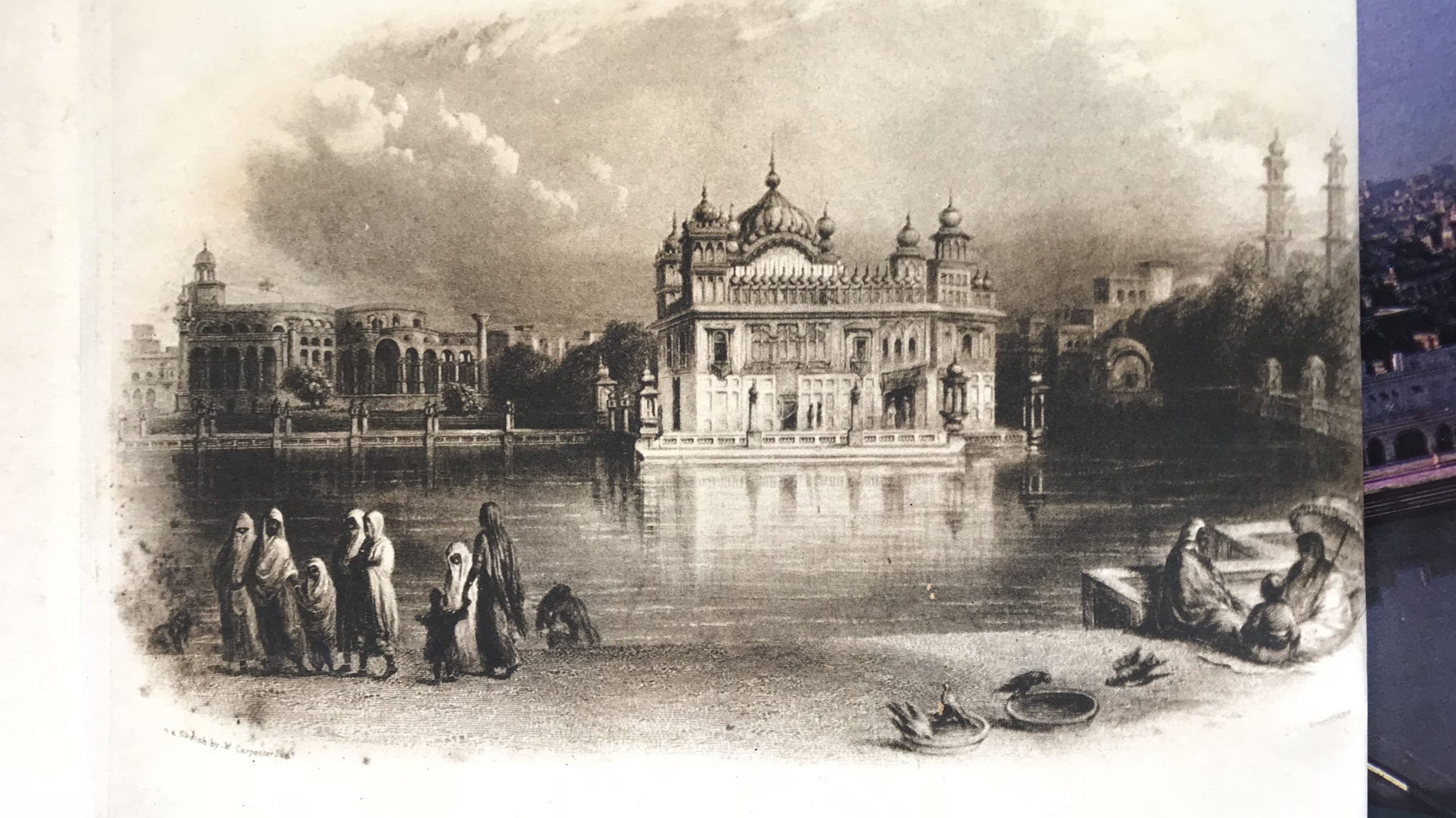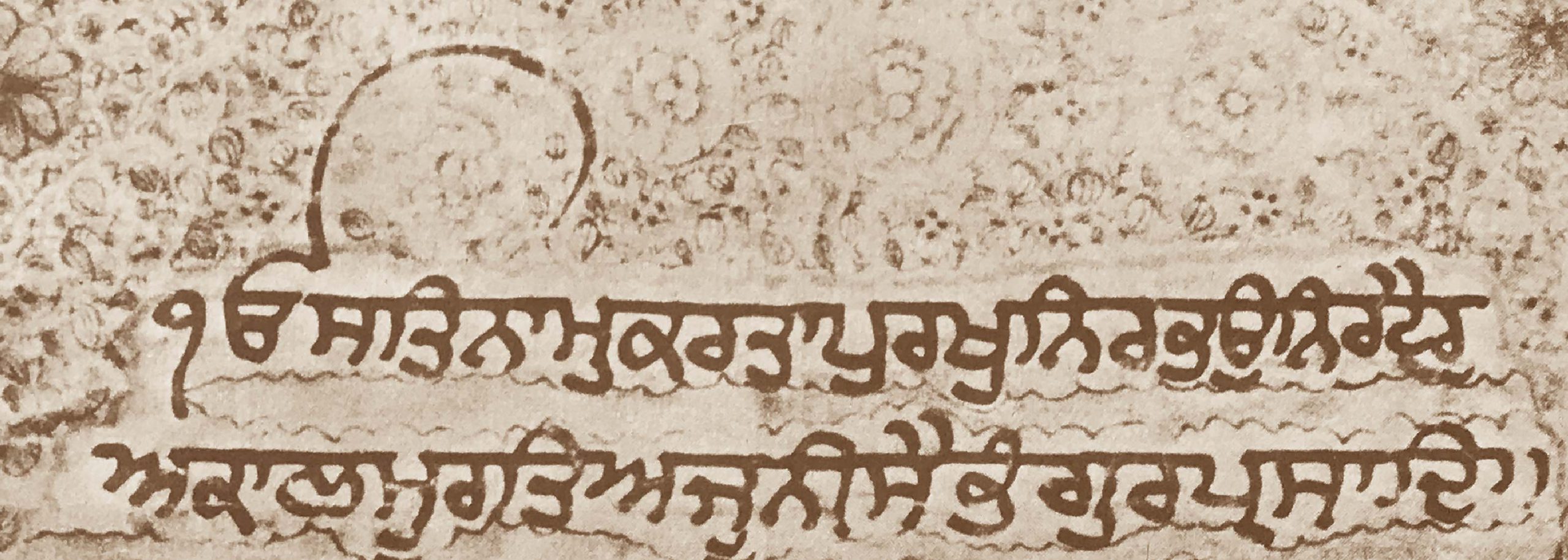Guru Nanak, the philosophical father of Sikhism was a great preacher of his times who equivocated an essence of life by suggesting the conquering of one’s mind and hence transform the thought process.
ਮਨਿ ਜੀਤੈ ਜਗੁ ਜੀਤੁ ॥
Man Jeethai Jag Jeeth ||
conquer your own mind, and conquer the world.
ਜਪੁ (ਮਃ ੧) ੨੮:੩ – ਗੁਰੂ ਗ੍ਰੰਥ ਸਾਹਿਬ : ਅੰਗ ੬ ਪੰ. ੧੭
Jap Guru Nanak Dev
Nanak was born at a time when discrimination of caste and creed were prevalent, misogyny at a constant high and polytheistic ritualism corroded the spirits of the common man.
Since the time immemorial, people have been warring with each other over their (perceived) differences of creed, appearance, tribe or origins. One of the most significant causes of quarrel was the worship of their respective Prophet, Avtar, God and Goddesses, and the dogma in their beliefs. This led Nanak in the journey for his search of enlightenment to spread the introductory message of Oneness.
At the time when the subcontinent believed in polytheism, Guru Nanak philosophized Ik Onkar. The depth of his belief in this theory of One Power guided him in laying the pillars of Sikhism on this word – Ik (One supreme light, the power that exists in every living being).
The expression Ik Onkar as propounded by Nanak and the following Gurus can be imagined as – the way rays light are dispersed from a prism in various directions just as the light of this One Supreme Being is observed across all living organisms. Let us imbibe these expressions below:
ਏਕ ਦ੍ਰਿਸਟਿ ਏਕੋ ਕਰਿ ਦੇਖਿਆ ਭੀਖਿਆ ਭਾਇ ਸਬਦਿ ਤ੍ਰਿਪਤਾਸੈ ॥੧॥ ਰਹਾਉ ॥
Eaek Dhrisatt Eaeko Kar Dhaekhiaa Bheekhiaa Bhaae Sabadh Thripathaasai ||1|| Rehaao ||
He looks impartially, equally upon all. He receives the charity of the Lord’s Love, and the Word of the Shabad, and so he is satisfied. ||1||Pause||
ਰਾਮਕਲੀ (ਮਃ ੧) (੧੧) ੧:੨ – ਗੁਰੂ ਗ੍ਰੰਥ ਸਾਹਿਬ : ਅੰਗ ੮੭੯ ਪੰ. ੧੪
Raag Raamkali Guru Nanak Dev
ਏਕਾ ਜੋਤਿ ਜੋਤਿ ਹੈ ਸਰੀਰਾ ॥
Eaekaa Joth Joth Hai Sareeraa ||
The One Light is the light of all bodies.
ਮਾਝ (ਮਃ ੩) ਅਸਟ (੨੭) ੧:੧ – ਗੁਰੂ ਗ੍ਰੰਥ ਸਾਹਿਬ : ਅੰਗ ੧੨੫ ਪੰ. ੧੦
Raag Maajh Guru Amar Das
This realization and recognition of One Supreme Reality became central to the teachings of Sikhism. One Essence, One Reality that sustains all. This is paramount to the understanding of the Sikh belief system. The followers of Guru Nanak and subsequent Gurus forwarded this belief system with tunnel vision – to be One with the supreme being or truth.
ਏਕਾ ਮਾਟੀ ਏਕਾ ਜੋਤਿ ॥
Eaekaa Maattee Eaekaa Joth ||
There is the one dust, the one light
ਗਉੜੀ (ਮਃ ੫) (੧੧੨) ੨:੧ – ਗੁਰੂ ਗ੍ਰੰਥ ਸਾਹਿਬ : ਅੰਗ ੧੮੮ ਪੰ. ੧੦
Raag Gauri Guru Arjan Dev
Nanak, to spread this message of Oneness would sing the praise of the Almighty (Kirtan) and people would gather around him irrespective of their background (social or economic). When Nanak settled in Kartarpur (Punjab) his hymns became a regular feature and thus, the concept of Gurdwara (Dharmsal) was formulated. Through Shabad, the divine word became the soul’s nourishment and sitting together to consume communal food (Langar) became the body’s nourishment. This community gathering eradicated the long-standing discriminatory mentality and attempted to bring about Oneness.
Guru Angad and Guru Amar Das, the next two successive Spiritual teachers, were quite integral in furthering this philosophy of Oneness. They formalized the practice of Pangat (rows for the langar) followed by subsequent Sangat (Congregation).
Guru Amar Das specifically found his belief in Oneness manifested through his efforts as a social reformer who condemned Sati and advocated widow remarriage. He was a great poet who through his poetry/hymns also conveyed this message.
The mantle of Sikhism and the ideology of Nanak continued on to the next successor – Guru Ram Das. He worked to bring about holistic development in the Sikh movement. He was a poetic genius and master composer who introduced several new ragas – meters. His heart touching lyricism mesmerized the listeners which brought in more followers to this Dharamshal of Guru Nanak. His dynamism revolutionized the concept of Ik and Oneness adding more dimensions to the perception of it.

In the late 1500s, the foundation of Ramdaspur (Amritsar) was laid and the construction of Ram Das Sarovar was started. Sikhs belonging to all strata of society from wealthy to the poor, trader to the labourer, were closely knit into one society and encouraged to use the same pond to bathe. The philosophy of Oneness exemplified what was required for civilized living – respect for all human beings of the One creator.
The era of Guru Arjan was prolific and energetic for Sikhs, they were accepted as the third most respected community after Hinduism and Islam. The foundation of the Harmandir, a most revered place, was one such development. It cemented the community a place in the annals of history. Harmandir’s foundation stone was laid by Hazrat Mia Mir, the spiritual leader of a different community.
This helps us realise how deep the belief of Oneness was ingrained in the Sikh psyche. They comfortably shared this laurel with an individual from a different religion. Therefore, it fueled the atmosphere with the confidence of interfaith appreciation in the times when caste or creed based discrimination had decimated cultures. The Almighty was not at the behest of any person and remained equally accessible to all.
The Harmandir itself proved a symbol for Oneness, as it was built on a level lower than the surroundings – inducing an act of humility to physically lowering of one’s ego to be in the devotion of One Truth; and four entry points to signify access to all the varnas of society. It was an open declaration to humanity about Sikhism’s metaphysical realisation of universality.
This was closely followed up by the gargantuan effort from Guru Arjan when he compiled the Guru Granth Sahib. Here he included the verses of the previous Gurus and prominent saints. The inclusions were of enlightened individuals whose ideology stemmed from the same school of thought and had a sublimity which our Gurus themselves showcased. The Guru Granth Sahib went on to attain the status of Living Guru for the Sikhs and is recognised by the rest of the world for its message. We must note that the Sikh philosophy of considering the Shabad (only in the Guru Granth Sahib) a living being, a personified Guru, is one of the only such documented practices in the world.
ਏਕੋ ਸਿਮਰਿ ਨ ਦੂਜਾ ਭਾਉ ॥
Eaeko Simar N Dhoojaa Bhaao ||
Meditate in remembrance on the One Lord; do not be in love with duality.
ਗਉੜੀ (ਮਃ ੫) (੧੬੫) ੧:੧ – ਗੁਰੂ ਗ੍ਰੰਥ ਸਾਹਿਬ : ਅੰਗ ੧੯੯ ਪੰ. ੪
Raag Gauri Guru Arjan Dev
Today, the followers of Guru Nanak spread all over the world are trying their best to live up to his teachings. Langars are being set up at places affected by natural and manmade calamities as well as for the impoverished ensuring that no creation of the Almighty is going to sleep hungry. The concept of Daswand (donating 10% of one’s income) is enabling us to practice social reform through our own individual lives. A universal message of Oneness is spread all over the world through televising Gurbani and allowing audiences worldwide to connect with the Shabad (Divine Word). What we may not realise is this constant stimulus of Oneness begins to instil in us a transcendence of thought. Our inner rhythms or beliefs find worthy physical manifestations through this to make for a symbiotic mind and matter relationship.
If this piece could leave you with one central message it would be this:
ਅਵਲਿ ਅਲਹ ਨੂਰੁ ਉਪਾਇਆ ਕੁਦਰਤਿ ਕੇ ਸਭ ਬੰਦੇ ॥
ਏਕ ਨੂਰ ਤੇ ਸਭੁ ਜਗੁ ਉਪਜਿਆ ਕਉਨ ਭਲੇ ਕੋ ਮੰਦੇ ॥੧॥
Aval Aleh Noor Oupaaeiaa Kudharath Kae Sabh Bandhae ||
Eaek Noor Thae Sabh Jag Oupajiaa Koun Bhalae Ko Mandhae ||1||
First, Allah created the Light; then, by His Creative Power, He made all mortal beings.
From the One Light, the entire universe welled up. So who is good, and who is bad? ||1||
ਪ੍ਰਭਾਤੀ (ਭ. ਕਬੀਰ) (੩) ੧:੧-੨ – ਗੁਰੂ ਗ੍ਰੰਥ ਸਾਹਿਬ : ਅੰਗ ੧੩੪੯ ਪੰ. ੧੯
Raag Parbhati Bhagat Kabir
